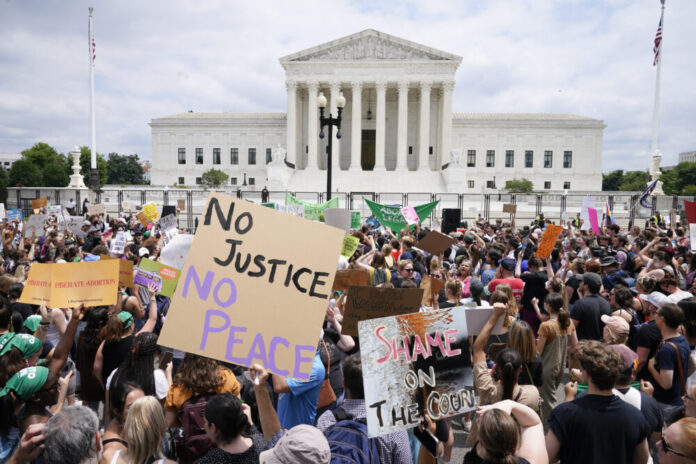
WASHINGTON — The Supreme Court on Friday stripped away the nation’s constitutional protections for abortion that had stood for nearly a half-century. The decision by the court’s conservative majority overturned the landmark Roe v. Wade ruling and is expected to lead to abortion bans in roughly half the states.
The ruling, unthinkable just a few years ago, was the culmination of decades of efforts by abortion opponents, made possible by an emboldened right side of the court fortified by three appointees of former President Donald Trump.
Both sides predicted the fight over abortion would continue, in state capitals, in Washington and at the ballot box. Justice Clarence Thomas, part of Friday’s majority, urged colleagues to overturn other high court rulings protecting same-sex marriage, gay sex and the use of contraceptives.
Pregnant women considering an abortion already were dealing with a near-complete ban in Oklahoma and a prohibition after roughly six weeks in Texas. Clinics in at least two other states, Wisconsin and West Virginia, stopped performing abortions after Friday’s decision.
Abortion foes cheered the ruling, but abortion-rights supporters, including President Joe Biden, expressed dismay and pledged to fight to restore the rights.
“It’s a sad day for the court and for the country,” Biden said at the White House. He urged voters to make it a defining issue in the November elections, declaring, “This decision must not be the final word.”
Marjorie Dannenfelser, president of SBA Pro-Life America, agreed about the political stakes.
“An entirely new pro-life movement begins today. We are ready to go on offense for life in every single one of those legislative bodies, in each statehouse and the White House,” Dannenfelser said in a statement.
The ruling came more than a month after the stunning leak of a draft opinion by Justice Samuel Alito indicating the court was prepared to take this momentous step.
It puts the court at odds with a majority of Americans who favored preserving Roe, according to opinion polls.
Alito, in the final opinion issued Friday, wrote that Roe and Planned Parenthood v. Casey, the 1992 decision that reaffirmed the right to abortion, were wrong had to be be overturned.
“We therefore hold that the Constitution does not confer a right to abortion. Roe and Casey must be overruled, and the authority to regulate abortion must be returned to the people and their elected representatives,” Alito wrote, in an opinion that was very similar to the leaked draft.
Joining Alito were Thomas and Justices Neil Gorsuch, Brett Kavanaugh, Amy Coney Barrett. The latter three justices are Trump appointees. Thomas first voted to overrule Roe 30 years ago.
Four justices would have left Roe and Casey in place.
The vote was 6-3 to uphold the Mississippi law, but Chief Justice John Roberts didn’t join his conservative colleagues in overturning Roe. He wrote that there was no need to overturn the broad precedents to rule in Mississippi’s favor.
Justices Stephen Breyer, Sonia Sotomayor and Elena Kagan — the diminished liberal wing of the court — were in dissent.
“With sorrow—for this Court, but more, for the many millions of American women who have today lost a fundamental constitutional protection—we dissent,” they wrote, warning that abortion opponents now could pursue a nationwide ban “from the moment of conception and without exceptions for rape or incest.”
The ruling is expected to disproportionately affect minority women who already face limited access to health care, according to statistics analyzed by The Associated Press.
Attorney General Merrick Garland said in a statement that the Justice Department will protect providers and those seeking abortions in states where it is legal and also “work with other arms of the federal government that seek to use their lawful authorities to protect and preserve access to reproductive care.”
In particular, Garland said that the federal Food and Drug Administration has approved the use of Mifepristone for medication abortions.
More than 90% of abortions take place in the first 13 weeks of pregnancy, and more than half are now done with pills, not surgery, according to the Guttmacher Institute, a research group that supports abortion rights.
Mississippi’s only abortion clinic, which was at the center of Friday’s case, continued to see patients Friday. Outside, men used a bullhorn to tell people inside that they would burn in hell. Clinic escorts wearing colorful vests used large speakers to blast Tom Petty’s “I Won’t Back Down” at the protesters.
Mississippi is one of 13 states, mainly in the South and Midwest, that already have laws on the books to ban abortion in the event Roe was overturned. Another half-dozen states have near-total bans or prohibitions after 6 weeks of pregnancy, before many women know they are pregnant.
In roughly a half-dozen other states, the fight will be over dormant abortion bans that were enacted before Roe was decided in 1973 or new proposals to sharply limit when abortions can be performed, according to Guttmacher.
West Virginia and Wisconsin, where clinics paused abortions, have bans dating from the 1800s.
The decision came against a backdrop of public opinion surveys that find a majority of Americans oppose overturning Roe and handing the question of whether to permit abortion entirely to the states. Polls conducted by The Associated Press-NORC Center for Public Affairs Research and others have consistently shown about 1 in 10 Americans want abortion to be illegal in all cases. A majority are in favor of abortion being legal in all or most circumstances, but polls indicate many also support restrictions especially later in pregnancy.
Outside the barricaded Supreme Court, a crowd of mostly young women grew into the hundreds within hours of the decision. Some shouted, “The Supreme Court is illegitimate,” while waves of others, wearing red shirts with “The Pro-Life Generation Votes,” celebrated, danced and thrust their arms into the air.
The Biden administration and other defenders of abortion rights have warned that a decision overturning Roe also would threaten other high court decisions in favor of gay rights and even potentially contraception.
The liberal justices made the same point in their joint dissent: The majority “eliminates a 50-year-old constitutional right that safeguards women’s freedom and equal station. It breaches a core rule-of-law principle, designed to promote constancy in the law. In doing all of that, it places in jeopardy other rights, from contraception to same-sex intimacy and marriage. And finally, it undermines the Court’s legitimacy.”
And Thomas, the member of the court most open to jettisoning prior decisions, wrote a separate opinion in which he explicitly called on his colleagues to put the Supreme Court’s same-sex marriage, gay sex and contraception cases on the table.
But Alito contended that his analysis addresses abortion only. “Nothing in this opinion should be understood to cast doubt on precedents that do not concern abortion,” he wrote.
Whatever the intentions of the person who leaked Alito’s draft opinion, the conservatives held firm in overturning Roe and Casey.
In his opinion, Alito dismissed the arguments in favor of retaining the two decisions, including that multiple generations of American women have partly relied on the right to abortion to gain economic and political power.
Changing the makeup of the court has been central to the anti-abortion side’s strategy, as the dissenters archly noted. “The Court reverses course today for one reason and one reason only: because the composition of this Court has changed,” the liberal justices wrote.
Mississippi and its allies made increasingly aggressive arguments as the case developed, and two high-court defenders of abortion rights retired or died. The state initially argued that its law could be upheld without overruling the court’s abortion precedents.
Justice Anthony Kennedy retired shortly after the Mississippi law took effect in 2018 and Justice Ruth Bader Ginsburg died in September 2020. Both had been members of a five-justice majority that was mainly protective of abortion rights.
In their Senate hearings, Trump’s three high-court picks carefully skirted questions about how they would vote in any cases, including about abortion.
___
Associated Press writers Jessica Gresko, Alanna Durkin Richer in Boston, Emily Wagster Pettus in Jackson, Mississippi and Scott Bauer in Madison, Wisconsin, contributed to this report.
For more from Fresh Take Georgia and the latest updates, follow us on Facebook and Twitter.















